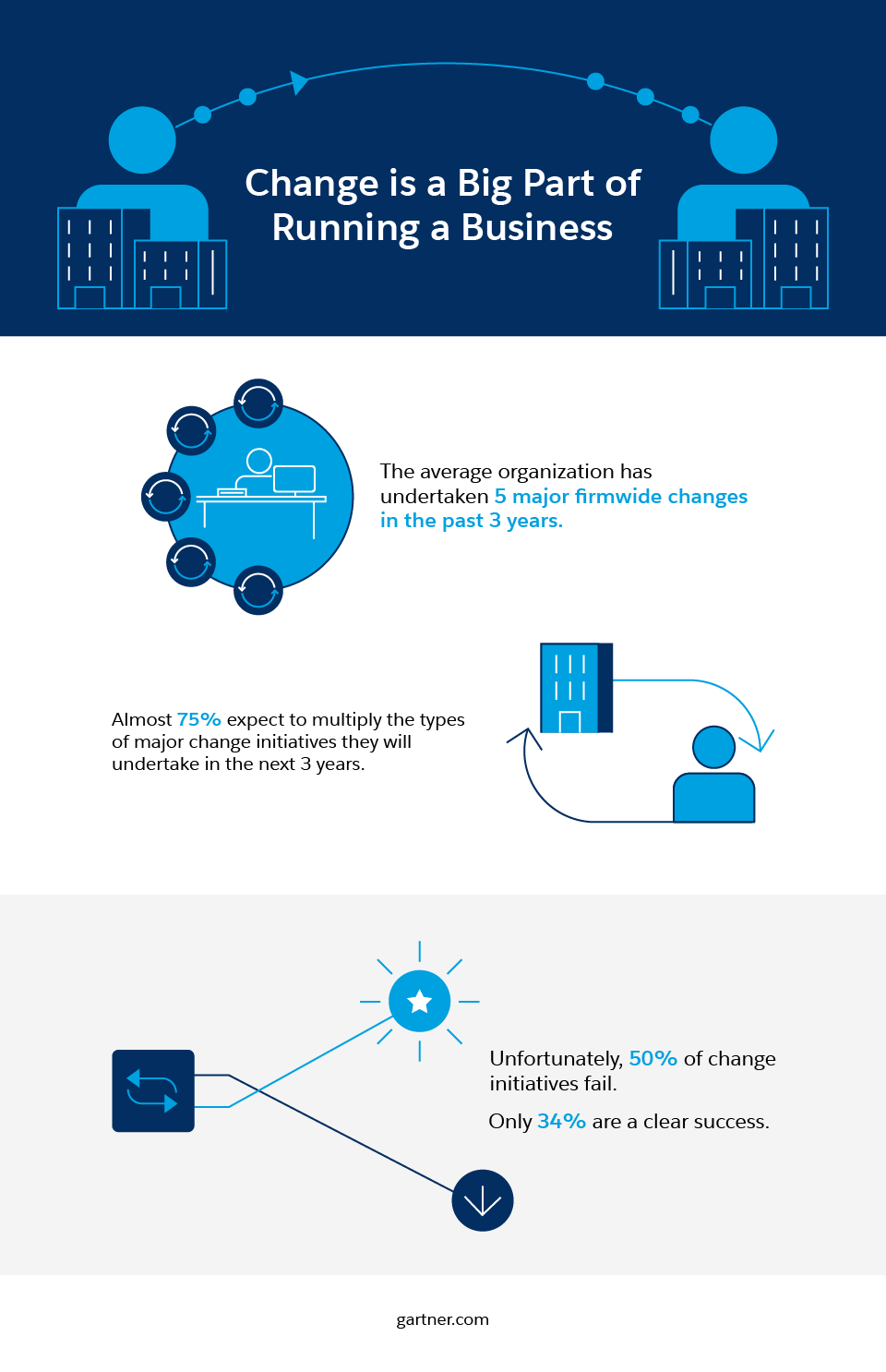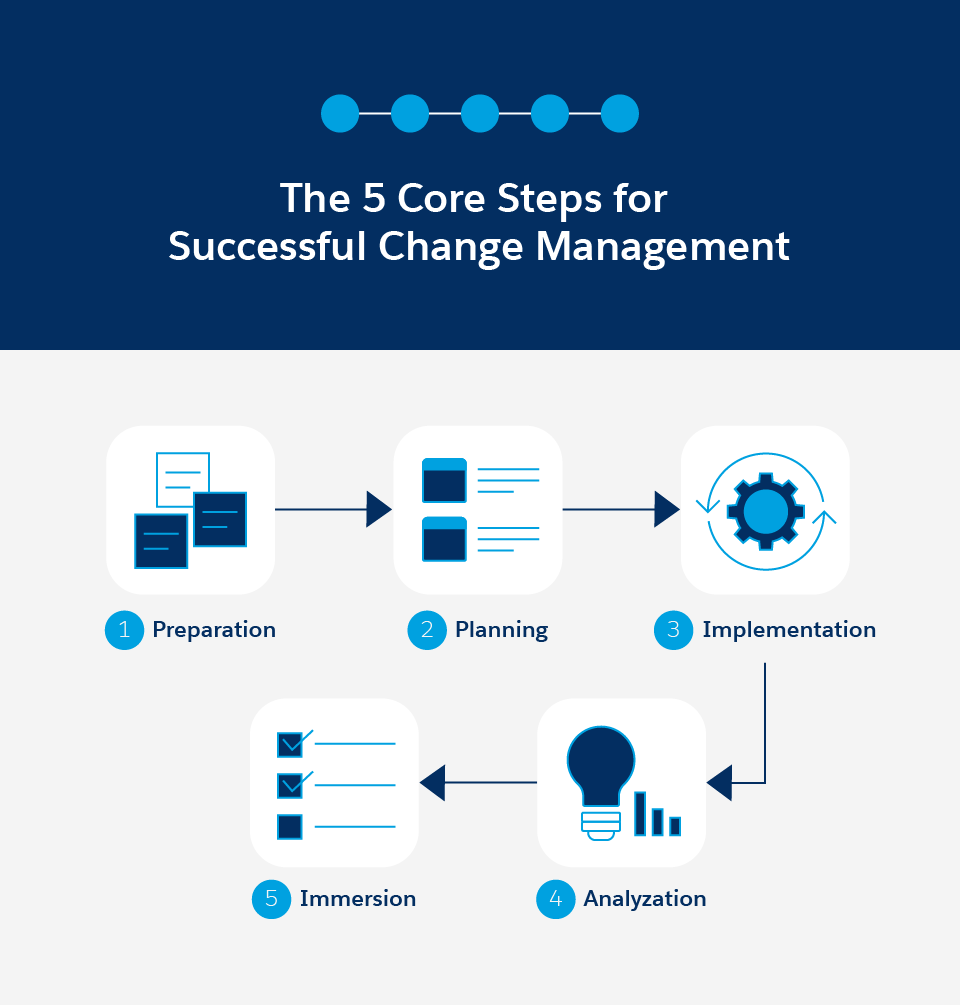The ability to adapt to change is an integral part of successful business growth. New technologies are constantly developed, new metrics must be tracked, and new competitors enter the market. How companies respond to change has long-term implications on growth, employee retention, and the success of new initiatives.
However, innovative changes can be difficult to implement and foster in order to deliver the anticipated results. According to Gartner, just 34 per cent of changes are considered a “clear success.”
How can companies ensure they use resources appropriately, keep employees engaged and on board, and push for changes that actually deliver results?
The answer is change management, a project management approach designed to create a smooth, effective change process.

What is Change Management?
Change management is a process that supports individuals and companies through changes, from the earliest stages of change planning to successful implementation and analysis of success.
The process guides organizations through the implementation of various types of change, including:
Technology innovations
Internal process reviews
Crises
Post-competitive analysis shifts
Organizational restructuring
Change management may also refer to several different types of change management, including individual, organizational, and enterprise change management.
What is the Purpose of Change Management?
The core purpose of change management is to address the impact of change on people. It helps both people and organizations reach their full potential through analyzing potential roadblocks, developing new skills, winning employee buy-in, reducing risks, and improving metric tracking.
People, after all, are a company's greatest asset. Change management supports and equips the people impacted by a change by helping them successfully navigate the change and reach their full potential.
An Example of Change Management
Here's a short example of change management to illustrate how the process can work. Say a financial company is implementing a new method for gathering customer complaint data to improve customer support and drive product development.
Without a change management plan, the company might send out an email, schedule a short training session, and launch the new initiative in a matter of days. The change is launched, but the company faces three important questions:
How many employees truly understand the changes?
How many employees have been trained to use the new system?
Do employees have the support required to successfully implement the new method?
A change management plan considers potential questions and makes sure they’re answered during the implementation of the change. In this case, the plan would outline the training customer support representatives and managers need to complete, explain in clear language why the new process is critical to the company's growth, and track usage of the new process.
Without change management, the company might waste thousands of dollars on fancy new systems no one knows how to use. Even worse, inaccurate data could drive multimillion-dollar business decisions. With a change management strategy in place, the company can proceed confidently.
What are the Benefits of Change Management?
Change management aims to drive adoption and usage to ensure organizational changes deliver the expected results. Essentially, change management is all about ensuring changes are effective and that the time and resources required to launch new initiatives are not wasted.
Six main benefits of change management include:
Clearly identify stakeholders and hold them accountable
Assess the need for change and predict the impact of the new initiative
Empower employees throughout the change process
Reduce the amount of time required to implement a change
- Mitigate risk associated with new processes
- Ensure the success of new initiatives

Five Steps of Successful Change Management
There are no cut-and-dry steps of successful change management. The type of change, the company’s size and industry, and the purpose of the change can all impact the steps in a number of ways.
That said, there are general steps to a successful change management process to consider. Those core steps include:
- Preparation: Prepare the company for the cultural and logistical changes to come by explaining the need for change and addressing the challenges that could arise during the process.
- Planning: Develop goals, outline metrics, identify stakeholders, and outline who is responsible for signing off on changes. Identify possible roadblocks and outline potential solutions.
- Implementation: Follow the steps outlined in the planning stage, adjusted as needed, in order to reach the goals outlined during planning.
- Immersion: After implementation, immersion embeds the changes in the culture and workflows of the company in order to prevent backsliding. Steps in this stage may include new reward structures, updating workflow documentation, and adjusting metrics.
- Analyzation: Review the change and the process the company followed to implement it. How has the change impacted the company? Were the metrics outlined in the planning stage the most accurate method for measuring success? Was the initiative successful as a whole?

Three Different Types of Change Management
Change management is a living process — meaning it updates, shifts, and adjusts often — that is unique to individual companies, processes, and industries. For example, an international technology company would not use the same change processes as a local printing company.
Understanding the differences between change management types is an important part of developing a successful change management process.
What is Individual Change Management?
Individual change management is the process of understanding the psychological and physiological reactions individual employees have or will have to the change process. It requires understanding what people need to successfully navigate changes at the organizational level.
Individual change management addresses how to get buy-in to the process, which types of training are most effective, and how to ensure new behaviours are maintained during and after completion of the change process.
What is Organizational Change Management?
While individual change management addresses how each person will respond to change, organizational change management addresses the steps required to successfully implement new processes at a wider, organizational level.
Steps in the organizational change management process include creating a plan for implementation, driving awareness, designing training and coaching programs, updating workflows, and measuring success.
What is Enterprise Change Management?
Enterprise change management is the process of planning, implementing, and tracking the success of changes in large enterprise companies. Rather than being a one-time process to improve a single change's success, enterprise change management seeks to embed the change management process into the company's culture.
Enterprise change management helps large companies compete by improving their ability to quickly and successfully implement new processes and technologies.
An Example of Change Management in Practice
Change management procedures must be adjusted to meet the needs of specific companies, employees, customer bases, and industries. Change management, in all its forms, aims to create a smooth process that ensures shifts in processes are smooth and successful.
For example, take a small clothing boutique. Sales have steadily increased over the years, and online sales increased slowly while the store focused most of its energy on creating a superior in-store experience. Then, in early 2020, in-store sales suddenly decrease.
The store must make a change — focusing on online sales is the only way the business will survive. But, most of the employees are trained to use a physical point of sale system (POS) and provide in-person customer service, not use the online ordering system or provide online customer support.
How does the store ensure its business can successfully pivot to prioritize online sales? The steps of change management listed above help break down a large shift into defined steps, including educating staff on why the change is necessary, outlining the skills employees need to learn, determining how to support the staff through the change, and measuring whether the change is successful.
Conclusion
Change management is crucial for the long-term success of businesses and organizations of all sizes. Preparing for change will help companies stay at the top of their industry by making it easier to implement new technologies, respond to crises, and leverage new skills quickly and efficiently.


